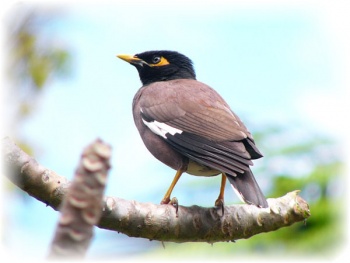- Acridotheres tristis
Identification
photo from Sydney, Australia.
The Common Myna, Acridotheres tristis, is a myna, a member of the starling family. This bird is a common resident breeder in tropical southern Asia from Afghanistan to India and Sri Lanka. It is also known as the Indian Myna or Talking Myna for its ability to mimic human speech.
It has extended its range into southeast Asia, and has been introduced widely elsewhere, including South Africa, Israel, Hawaii, North America (especially in southern Florida), Australia, New Zealand and the United Arab Emirates.
This abundant passerine is typically found in open woodland, cultivation and around habitation. The Common Myna builds a nest in hole in a tree or wall. The normal clutch is 4-6 eggs. They are popular as cage birds for their singing and "speaking" abilities.
This 25 cm long bird has dark brown body and wing plumage, with large white wing patches obvious in flight. The head and throat are dark grey. The bill, bare skin around the eyes and strong legs are bright yellow. The sexes are similar. Mynas mate for life.
Like most starlings, the Common Myna is omnivorous. It feeds on insects and fruits and discarded waste from human habitation. It forages on the ground among grass for insects, and especially for grasshoppers from which it gets the generic name Acridotheres, "grasshopper hunter". It walks on the ground with occasional hops.
The song includes croaks, squawks, chirps, clicks and whistles and it often fluffs its feathers and bobs its head in singing. The Common Myna screeches warnings to its mate or other birds in cases of predators in proximity.
Introduced
Introduced to Australia in late1800s,also as established escaped cage birds in Europe,N Africa,Arabia.Abundant in Aust and is a pest as well as a competitor with native species,spreads alien pest plants.Status in its other new homes is unknown to me.
Originally posted by Dimitris




